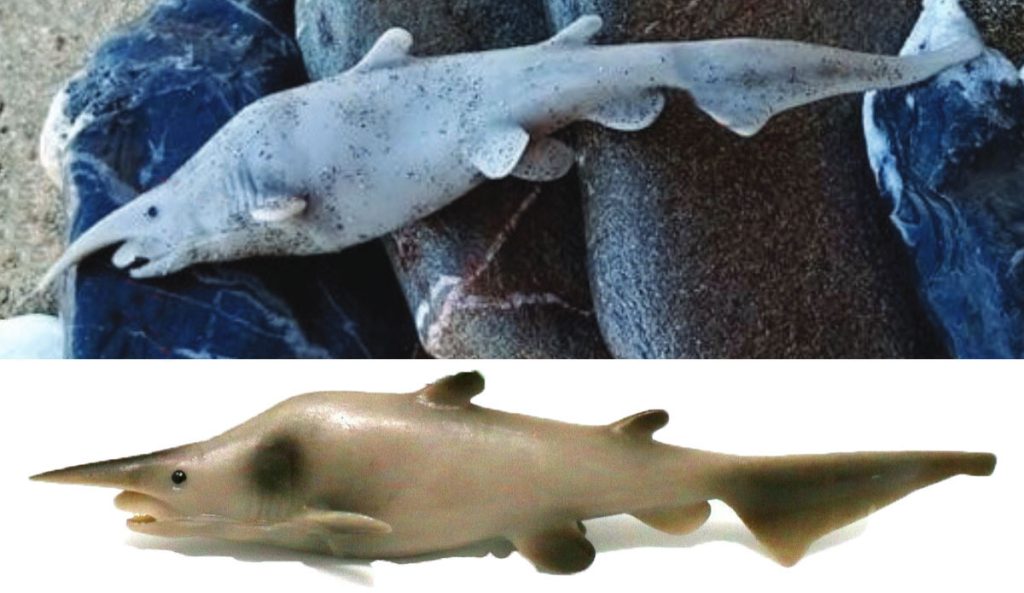Goblin shark – Mitsukurina owstoni
Sometimes called a living fossil in the family Lamniformes, the prehistoric looking goblin shark is the only species in its own family the Mitsukurina. A rarely seen shark, they have been described from deepwater nets and trawls in the Atlantic, Western Indian and Pacific Oceans, but never from the Mediterranean.
In 2022, researchers published a paper called New Records of rare species in the Mediterranean Sea, from the photograph of a dead, juvenile goblin shark, that had apparently been found on a beach in Greece. In 2020, a man walking on Greece’s Anafi Island beach discovered a weird looking fish. He picked the specimen up and took a picture of it, and then sent it to a group of scientists. From the photograph, the scientists described and published the alarming scientific find of a first description of this species observed in the Mediterannean Sea in the journal Mediterranean Marine Science.
Since goblin sharks are rarely found, and it had never been observed in the Mediterranean Sea, other scientists scrutinized the paper. The scientists examined the paper more closely, including the image provided. Noting the shape of the jaw, the incorrect number of gills, the rigidity of the fins of the shark in the photograph, and the lack of detail in the article description, they determined it was a plastic toy. Similar sharks have been described from photos on eBay!
April Fool!

A comparison of the “real” Goblin shark and the eBay Goblin shark. Photos: eBay//Mediterranean Marine Science
Goblin sharks are a pinkish- white shark with a soft, flabby body with an unmistakable flat, elongated snout. The long snout has numerous ampullae of Lorenzini that can detect weak electric fields produced by other animals. It has protrusible jaws with sharp teeth that can extend nearly to the end of the snout. It has a long tail fin with no ventral lobe. The two dorsal fins are small and rounded and similar in size and shape. The pectoral fins are also small and rounded. The eyes are small and lack protective nictitating membranes.
SIZE
Males mature at 8.7 ft (2.64 m) and females mature at 11 ft (3.35 m). Their maximum size is estimated to be more than 16.4 ft (5.00 m).
TEETH
Long-cusped, slender teeth and are finely grooved lengthwise. The teeth in the main part of the jaws are long and narrow, particularly those near the symphysis (jaw midpoint).
HABITAT
These sharks prefer deepwater, on outer continental shelves, upper slopes and off seamounts. They very rarely surface, and usually remain at depths of 885.8 to 3149.6 ft (270 to 960 m), to at least 4265.1 ft (1300 m).
DISTRIBUTION
These sharks have a patchy distribution, described from deepwater in the Atlantic, Western Indian and Pacific Oceans. It has been collected from seamounts along the Mid–Atlantic Ridge, and in submarine trenches off the coast of Japan. One Eastern Pacific specimen has been described, collected off Southern California.
BIOLOGY
Only a few specimens have been collected alive and maintained in aquariums, and they survived only briefly from 2 days to less than two weeks. Prey include soft-bodied teleost fishes such as rattails and dragonfishes. It also consumes invertebrates including cephalopods and crustaceans such as decapods and isopods. Garbage has been observed in the stomachs dissected from some specimens. Goblin sharks have been identified in the gut contents of blue sharks (Prionace glauca)
BEHAVIOR
This shark’s body suggests that it is a poor swimmer. Its blade-like snout may be used to detect prey, and its highly specialized jaws can rapidly eject forward to snap up prey. Its slender front teeth suggest a diet of small, soft-bodied fishes and squid, but the back teeth are modified to crush food.
STATUS
The International Union for Conservation of Nature (IUCN) has categorized the goblin shark as Least Concern. A deep water species, they are caught as bycatch. This shark is not targeted but is hooked on longlines, occasionally killed as bycatch in bottom gillnets and trawls, or entangled in fishing gear.
Kids, learn more about the Goblin shark and other weird species in our book Sharks for Kids!